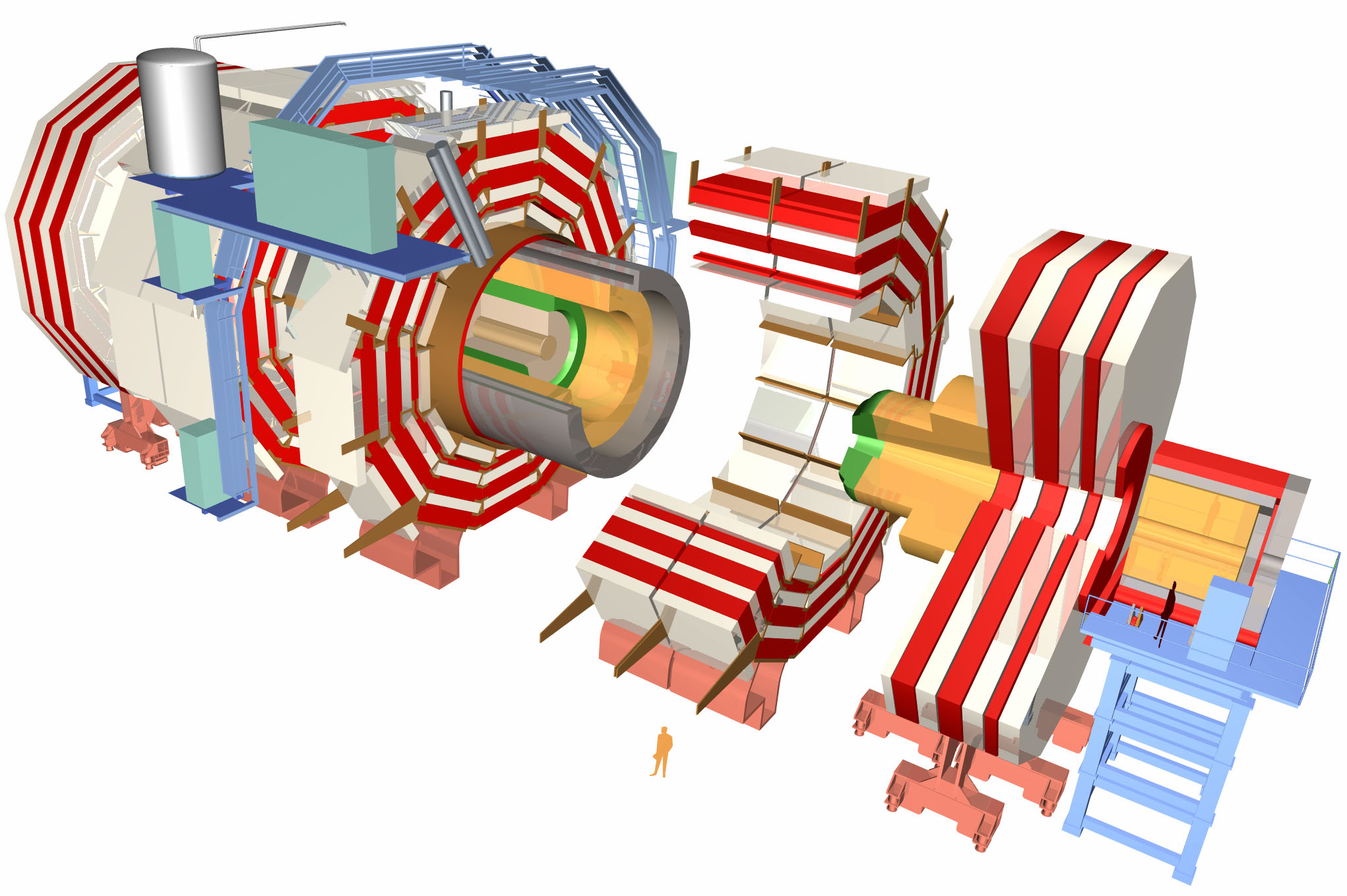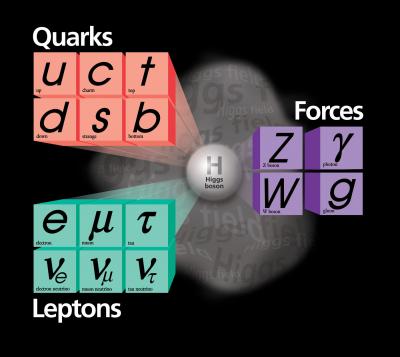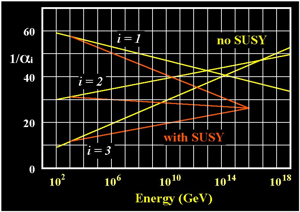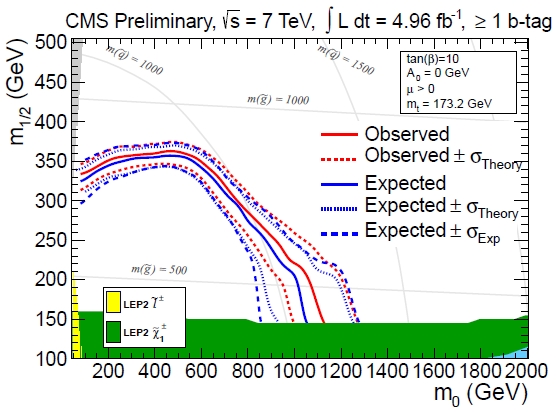CMS (see a 3-D sketch below) is one of the two huge detectors collecting the faint signals of particles produced in the powerful 8-TeV proton-proton collisions delivered by the CERN Large Hadron Collider. The CMS experiment has recently been publishing one by one the results of many largely independent searches for Supersymmetric particles in the data collected during 2011; not surprising to sceptics like me, these results are all "negative" ones: they describe the absence of a signal, which is however a very informative datum, since it can be turned into a bound on possible models of new physics.
 Here we are talking about supersymmetry (SUSY for friends): an extension of the Standard Model (SM) of particle physics which entails the existence of a whole set of new subatomic particles, none of which have so far been seen. The leap of faith one needs to take in order to believe that Supersymmetry is the correct theory of Nature is considerable, since not just one new entity is hypothesized, but over two dozens, each with its own independent set of properties, and interacting according to not completely specified rules.
Here we are talking about supersymmetry (SUSY for friends): an extension of the Standard Model (SM) of particle physics which entails the existence of a whole set of new subatomic particles, none of which have so far been seen. The leap of faith one needs to take in order to believe that Supersymmetry is the correct theory of Nature is considerable, since not just one new entity is hypothesized, but over two dozens, each with its own independent set of properties, and interacting according to not completely specified rules. You need well over 100 new parameters -ones not predicted by theory- in order to specify the phenomenology of SUSY. So why can't one just dismiss the model (not even a theory, but rather a framework of theories) with a slash of Ockham's razor ?
Indeed, some of us -including yours truly- believe that SUSY is too much to buy. And yet, the new theory does produce some beneficial fixes to the Standard Model. Three things in particular need to be mentioned, and appreciated for their potential "healing value", before you can join the crowd of sceptics.
 One: the Standard Model (on the left, the particles which make up matter according to the SM, quarks and leptons, and the bosons that bind them together are all connected to the grey "Higgs field" lying behind) as is cannot explain a very puzzling riddle, the so-called "naturalness problem".
One: the Standard Model (on the left, the particles which make up matter according to the SM, quarks and leptons, and the bosons that bind them together are all connected to the grey "Higgs field" lying behind) as is cannot explain a very puzzling riddle, the so-called "naturalness problem". This boils down to the observation that if the Higgs boson exists, it has a mass which is close to the mass of the electroweak bosons by pure chance, being as is the result of the addition and subtraction of a dozen "quantum correction" terms each of which is orders and orders of magnitude larger than the mass itself. This "one in a billion billion" chance that the Higgs mass turns out by chance to be of the scale of electroweak symmetry breaking, while each of these correction terms would make it enormously larger, is especially unpleasing to theorists, and a symptom that something is unexplained. SUSY, with the introduction of a bosonic particle for each SM fermion and a fermionic partner to each SM boson, automatically cancels all the quantum corrections to the Higgs mass, making the problem of naturalness vanish quicker than you can say "mass".
 Two: if dark matter exists, and is as common in our Universe as cosmological measurements make it (on the right, the "bullet cluster" of galaxies, one of the most direct evidences we have for dark matter in the Universe), then we need something to explain it with. However, it is difficult to come up with dark matter candidates that do not contradict some additional measurement or observation; while a SUSY neutral particle, the lightest of all SUSY particles and thus prevented from disintegrating into anything lighter, might fit the bill extremely well. If a SUSY "neutralino" existed, it would have been created in the big bang. Now if its mass were in the 100-GeV ballpark, this would explain the amount of dark matter we seem to detect in the Universe, and 100 GeV is just about the correct scale of mass we "expect" for SUSY particles (otherwise they fail to produce the healing effect just discussed on the naturalness issue).
Two: if dark matter exists, and is as common in our Universe as cosmological measurements make it (on the right, the "bullet cluster" of galaxies, one of the most direct evidences we have for dark matter in the Universe), then we need something to explain it with. However, it is difficult to come up with dark matter candidates that do not contradict some additional measurement or observation; while a SUSY neutral particle, the lightest of all SUSY particles and thus prevented from disintegrating into anything lighter, might fit the bill extremely well. If a SUSY "neutralino" existed, it would have been created in the big bang. Now if its mass were in the 100-GeV ballpark, this would explain the amount of dark matter we seem to detect in the Universe, and 100 GeV is just about the correct scale of mass we "expect" for SUSY particles (otherwise they fail to produce the healing effect just discussed on the naturalness issue). Three: if SUSY is the correct theory of Nature, the different known forces have a chance to automatically "unify" at a very high energy scale (right lines merging in the graph on the left). This is a rather difficult concept to explain in a few words, but maybe suffices to say that the forces of Nature (the bitch, not the magazine) are supposed to be different manifestations of a "unified field", which behaves as different forces at the low energy at which we observe it. With SUSY in the theory, the way we observe these forces to vary with the energy of the studied processes would imply that they all become of the same intensity at a very high energy -unfortunately one not really accessible by experiment. Without SUSY, the forces do not become all equal at the same energy scale.
Three: if SUSY is the correct theory of Nature, the different known forces have a chance to automatically "unify" at a very high energy scale (right lines merging in the graph on the left). This is a rather difficult concept to explain in a few words, but maybe suffices to say that the forces of Nature (the bitch, not the magazine) are supposed to be different manifestations of a "unified field", which behaves as different forces at the low energy at which we observe it. With SUSY in the theory, the way we observe these forces to vary with the energy of the studied processes would imply that they all become of the same intensity at a very high energy -unfortunately one not really accessible by experiment. Without SUSY, the forces do not become all equal at the same energy scale.All the above said, SUSY remains on shaky ground nowadays, since the LHC experiments are shooting down one after another its many possible manifestations. The analysis recently published by CMS I am discussing today is a search for proton-proton collisions that produce high-energy electrons or muons, accompanied by large missing transverse momentum and b-quark jets. Ok, ok, don't leave just yet - I am going to explain what that means.
Protons are made of quarks -hadronic matter, that's how we call it. All different are leptons, such as the electron and the muon. The latter particles are not normally found in a proton-proton collision, no more than you can find a diamond in the debris resulting from launching two pieces of clay one agains the other. The energetic electron or muon you rarely find in a proton-proton collision signals that some rare interaction has occurred in the collision or shortly thereafter: quite possibly a W boson decay, but maybe -just maybe- something more exotic, like a SUSY particle decay.
As for missing transverse momentum: if you had launched the two pieces of clay quite straight at one another, you would be surprised to see all the debris flying out in one direction (different from the line of initial motion) after the collision, wouldn't you ? You reason that if the debris flies all to the left, there has to be something "recoiling" against it that left going to the right. This is what physicists call "missing transverse momentum": they detect particles all around the collision, and by adding up the momenta of what they see, they infer the possible escape of something they did not see. A neutrino is the most likely candidate, but a neutralino could also fit the bill.
And then, b-quarks. These are sought because they are heavy, and in many manifestations of SUSY the b-quarks may be produced in the decay of SUSY top quarks (stop quarks). SUSY-tops may be lighter than other SUSY particles because of some kind of "inverted hierarchy": what is light in the SM is heavy in SUSY, and vice versa. Being light, stop quarks would be readily produced SUSY particles, and so they constitute an easier prey in the powerful, but still energy-limited collisions produced by the LHC.
 Now, if you search for leptons, missing momentum, and b-jets, what do you get at a hadron collider ? You get most of the times regular SM top quarks. That is because the top quark decays to a W boson and a b-quark, and the W boson often produces a lepton and missing momentum (when the neutrino which they create escapes the detector). So top quarks are the nastiest background in this SUSY search. In the graph on the right, displaying the data as a function of the sum of detected transverse energy of all the observed particles (HT), you can see CMS experimental data (black points in the top panel) overlaid to a sum of the background processes that are believed to have been selected by the particular data processing of this analysis: the red component, the most copious one (beware, this is a logarithmic plot, so the largest component is not the brown one with the largest area, but the one on top!), is indeed constituted by the production and decay of top quarks.
Now, if you search for leptons, missing momentum, and b-jets, what do you get at a hadron collider ? You get most of the times regular SM top quarks. That is because the top quark decays to a W boson and a b-quark, and the W boson often produces a lepton and missing momentum (when the neutrino which they create escapes the detector). So top quarks are the nastiest background in this SUSY search. In the graph on the right, displaying the data as a function of the sum of detected transverse energy of all the observed particles (HT), you can see CMS experimental data (black points in the top panel) overlaid to a sum of the background processes that are believed to have been selected by the particular data processing of this analysis: the red component, the most copious one (beware, this is a logarithmic plot, so the largest component is not the brown one with the largest area, but the one on top!), is indeed constituted by the production and decay of top quarks.The agreement of the data with expected backgrounds shown in the figure above is not a surprise: it is what happens day in and day out to SUSY particle hunters. The next step is to evaluate what is the maximum size of a SUSY signal that could be hiding in the observed data, without us being able to see it, being smaller than statistical fluctuations of the backgrounds. This is what is called a "upper limit setting procedure". It entails applying some quite sophisticated statistical methods. CMS is here using a frequentist technique based on the criterion called "CLs" from the days of LEP II, which sought with it the Higgs boson in the late nineties. CLs might be argued to not be the best criterion for a upper limit setting procedure, but is a common practice at hadron colliders nowadays, and speaking a common language is more important than other considerations.
In the end, CMS extracts a limit on the number of signal events, for a number of different manifestations of SUSY signatures. The set of upper limits is translated in an exclusion of points in a two-dimensional parameter plane: the points corresponding to masses M_1/2 and M_0 to the left and below the red curve in the graph below are excluded by the search.

The curve to concentrate on, the real CMS result, is the full red one: the dashed red curves surrounding it show how much the result could vary if one were to move the central value of the theoretical prediction for the SUSY particle production rates up and down by their relative uncertainty. That is because the set of exclusion points determined by the CMS search depends on comparing the observed upper limit to the number of SUSY events predicted by the theoretical model, as a function of the M_1/2 and M_0 masses. If you vary the model calculation, you get a different answer, to some extent.
Also note that in blue are drawn several different additional curves. These describe the region of parameter space that the experiment could expect to exclude, given the technique and the size of analyzed dataset. Possible ranges of these expected regions are shown with different dashes. You should also care to observe that the region of parameter space excluded is valid for a specific choice of a few other crucial SUSY parameters, the ones listed in the top right legend. If one were to vary these parameters, the excluded range would change.
In the end, a good summary of the result can be given as follows: no SUSY particles are observed in final states including leptons, missing momentum, and b-quark jets. Some chunks of SUSY parameter space can therefore be excluded, at 95% confidence level. If you need more detail, however, you are welcome to browse the CMS paper, which contains lots of additional information.
This year, the LHC is running at 8 TeV (while the 2011 data were collected at 7 TeV centre-of-mass energy). The added collision energy, together with the foreseen four-fold increase in data size, will allow CMS and its competitor ATLAS to investigate a much wider chunk of parameter space points. And who knows, maybe SUSY will be found to have been hiding in that region for all this time... It would be surprising, exhilarating, and ground-breaking. But unfortunately, it is also improbable!




Comments